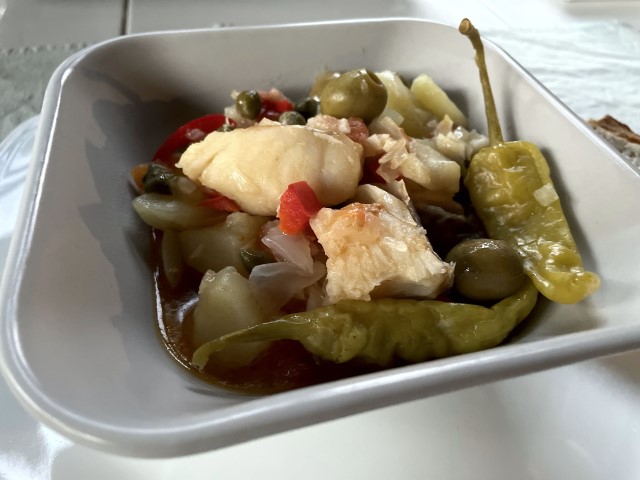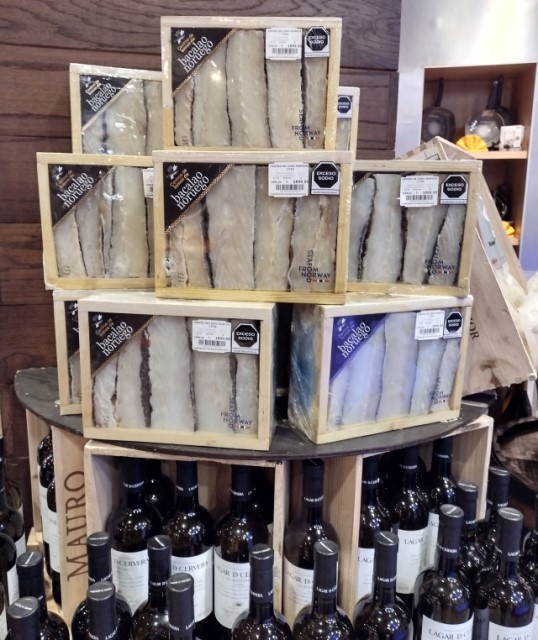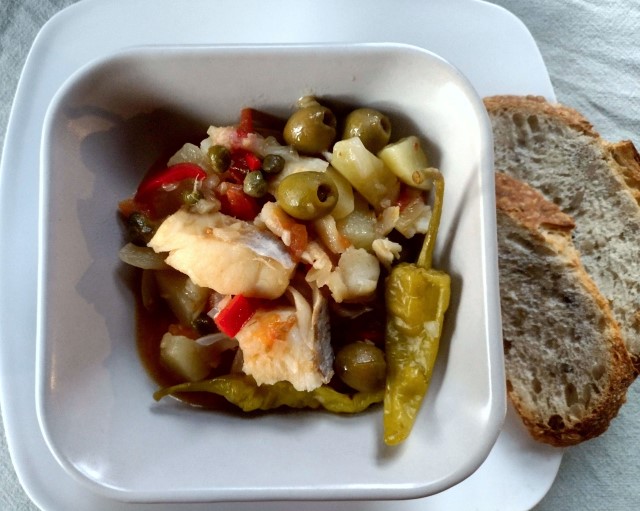During the December holidays, people in Mexico enjoy the traditional fiesta delicacies like different moles, tamales plus several seasonal dishes like turkey, pierna de puerco, and Bacalao a la Vizcaína. At home, I call the last one Bacalao a la Mexicana, here is why: when I was growing up, every year my mother pulled the recipe from a kitchen drawer and executed it to perfection. The recipe was printed in an old piece of cardboard that was cut off from a box where Norwegian salted cod came packed. And when I say “an old piece of cardboard” I’m talking about the 1950s!
The title of that recipe was Bacalao a la Mexicana, so I only knew it with this name. As I visited other homes and restaurants, I noticed that everybody called it Bacalao a la Vizcaína, the same dish but with a slightly different name indicating its origin. As usual, every cook claimed this was the original Spanish recipe and often a family secret. I always wondered how secret it could be when the recipe came printed on the side of thousands of cardboard boxes where the salted cod was packed for sale.
Bacalao a la Vizcaína most likely arrived in La Nueva España—that was the official name of today´s Mexican Republic—when it was a colony of Spain between 1521 and 1821. The country was governed then by Viceroys, envoys representing the King from Spain. The Spanish conquest was first military, then religious and finally cultural, which severely influenced life for 300 years and beyond. Catholicism, urbanism, language, the mixing of races, and all other cultural manifestations—including gastronomy—were developed at a high rate during this time until 1821 when Mexico became independent from Spain. Once in La Nueva España, Bacalao a la Vizcaína—like many other dishes— was “tropicalized” by adding native ingredients, such as tomatoes, potatoes and the ubiquitous chiles.

Chunky Bacalao a la Mexicana, Photo by Natalia Marmolejo
From Basque origin, Bacalao a la Vizcaína, from the Vizcaya province, in the north of Spain, bordering the Atlantic Ocean, is made with cod (Gadus morhua) that does not come from the Atlantic Ocean. It is caught in the cold waters of the northern Norwegian coast where it arrives to spawn from the ice-cold waters of the Barents Sea.
Catching cod is an industry as old as the Viking age and a way of life for many Norwegian towns and cities that export cod to the rest of Europe and the entire world. Salted Norwegian cod was adopted by the Basques and introduced to other peoples throughout Europe, including the English, the Portuguese (which turned into a national dish) and the Neapolitans to mention just a few. Fresh and dried cod is today one of Norway’s most important export products and Norwegian salted cod represents 90% of the salted cod sold in the world.

Norwegian salted cod in a supermarket
Cod fishing occurs from January to April and the drying process begins immediately. The fish is beheaded, gutted and butterflied then set to dry for several months on racks in the open cold, dry and somewhat salty air of Norway. Once dried, it is brought indoors where salt is added and the maturing process occurs.
Not much in this industry is wasted. The tongue is fried and considered a local delicacy. The liver is much sought after to extract its healthy oil for humans which is rich in vitamins and omega 3. The cod heads are exported to Nigeria where they are used to make a stock used in many dishes. The roe is cooked to produce a caviar of excellent quality, and to top it all, the Norwegian cod population is managed sustainably, which guarantees the supply for generations to come!
Bacalao a la Vizcaína or better yet Bacalao a la Mexicana somehow became a popular dish for the December holidays in Mexico. Large quantities are cooked and leftovers consumed in tortas for days until completely exhausted. It is found on the tables of the privileged class and in some not so privileged but willing to splurge this time of the year. It has become traditional all over Mexico, a dish with a long history and evolution whose main ingredient comes from far away cold waters, preserved with an ancient technique and arrives to rest in our warm palates… ¡Felices fiestas!
Bacalao a la Mexicana Doña Luz Recipe
This recipe came printed on the side of the cardboard boxes that contained Norwegian salted cod in the 50´s. My Mother Doña Luz added the red bell peppers and fine herbs.

Bacalao a la Mexicana, Photo by Natalia Marmolejo
Ingredients
- 1 lb. Norwegian salted cod
- 1 lb. potatoes cooked, peeled, and cut in small cubes
- 1 onion chopped
- 3 garlic cloves finely chopped
- ⅓ to ½ tomatoes chopped
- ⅓ to ½ cooking olive oil
- 6 oz. chile guero in brine
- 4 to 6 oz. pitted olives
- 4 to 6 oz capers
- Black peppercorns to taste
- 2 bay leaves
- 2 red bell peppers chopped
- Fine herbs to taste
- Salt to taste
Instructions
- Rinse the cod and soak it in water for a day changing the water every 8 hours.
- Boil the fish with the herbs between 15 and 20 minutes. Remove and let it cool off. Shred and remove any bones present.
- In a deep pan fry the bell peppers, onions, garlic and tomatoes. Add the shredded fish, olives, capers, black peppercorns, chiles and fine herbs. Taste for salt and add if necessary. Enjoy!
Latest posts by Mark Masker (see all)
- 2024 Scovie Awards Call for Entries - 07/07/2023
- 2024 Scovie Awards Early Bird Special: 3 Days Left - 06/29/2023
- 2024 Scovie Awards Early Bird Deadline Looms - 06/25/2023








